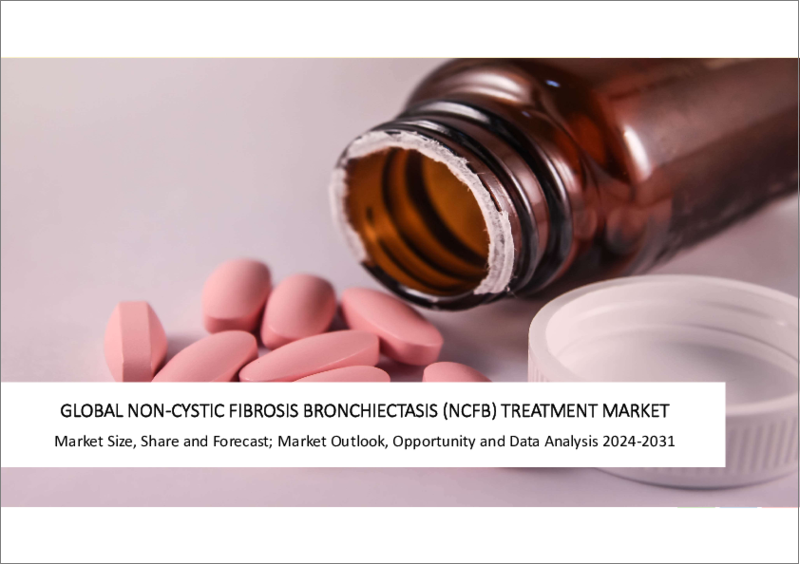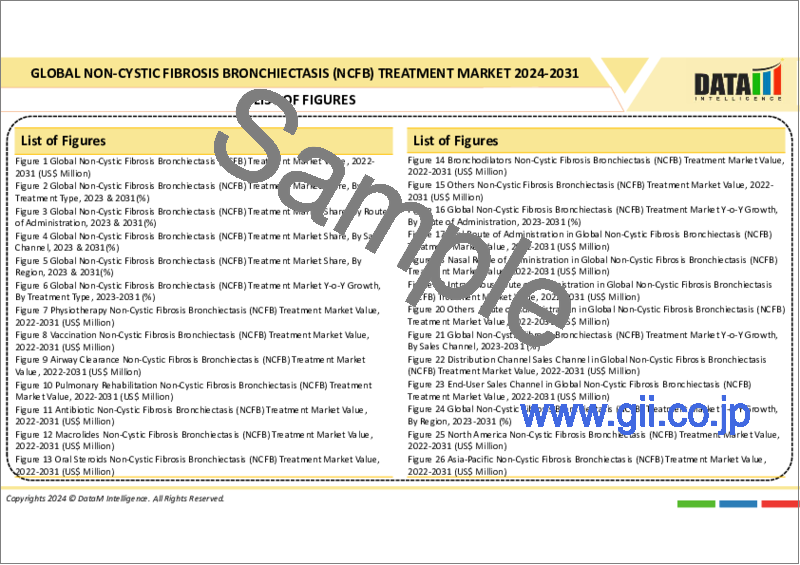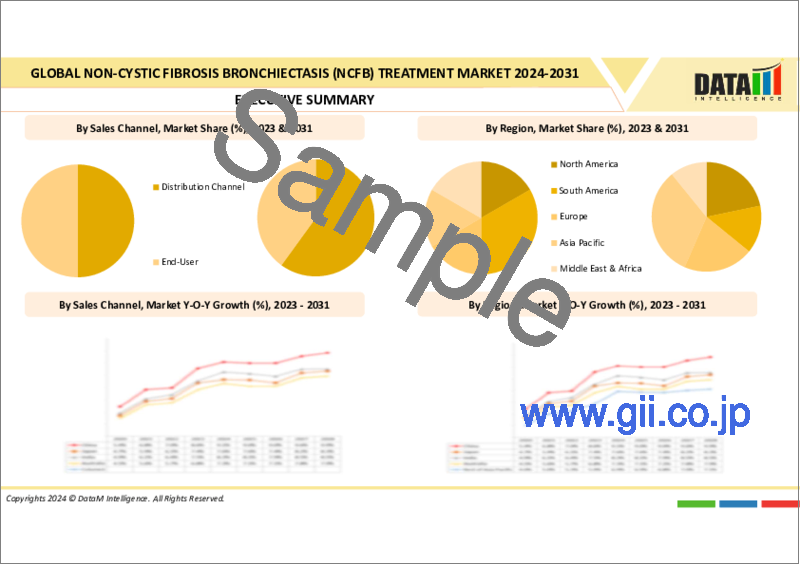|
|
市場調査レポート
商品コード
1374835
非嚢胞性線維症気管支拡張症(NCFB)治療の世界市場-2023年~2030年Global Non-Cystic Fibrosis Bronchiectasis (NCFB) Treatment Market - 2023-2030 |
||||||
カスタマイズ可能
適宜更新あり
|
|||||||
| 非嚢胞性線維症気管支拡張症(NCFB)治療の世界市場-2023年~2030年 |
|
出版日: 2023年11月01日
発行: DataM Intelligence
ページ情報: 英文 187 Pages
納期: 即日から翌営業日
|
- 全表示
- 概要
- 目次
概要
非嚢胞性線維症気管支拡張症(NCFB)は、慢性進行性の呼吸器疾患であり、不可逆的に異常に拡張した気道、持続的な咳、過剰な喀痰分泌、再発性の肺感染症を特徴とします。肺炎、繊毛の異常、免疫不全など様々な要因により発症します。高齢者に多く発症します。NCFBに罹患した患者は一般的に罹患率が増加し、QOLが悪化します。
また、NCFBは治癒することはありませんが、治療により管理することは可能です。治療には、ベスト型気道クリアランスシステムや呼気陽圧バルブなど様々なタイプの気道確保装置を使用した気道確保が最も一般的に使用されています。肺炎球菌やインフルエンザのワクチン接種、気道粘液分泌と粘性を低下させるためにマクロライド系薬剤の使用、細菌負担を低下させ炎症マーカーの大部分を低下させるために抗生物質の使用、理学療法、肺リハビリテーション、気管支拡張剤も重症度の管理に使用されます。
市場力学:促進要因
規制当局別承認と新薬上市の増加
規制当局による承認の増加と新薬の上市が、予測期間中の市場を牽引すると予想されます。FDA承認などの規制当局の承認は、新薬や治療法が安全に市場に参入する道を開く。このような治療選択肢の拡大は、患者により多くの選択肢を提供し、個々の患者のニーズや特性に基づいた個別化治療計画を可能にします。こうした規制当局の承認は、新薬の使用に対する患者の信頼を高めます。
例えば、2020年6月8日、重篤な希少疾患患者の生活を変革することを使命とする世界のバイオ医薬品企業であるインスメッド・インコーポレイテッドは、米国食品医薬品局(FDA)より、非嚢胞性線維症気管支拡張症(NCFB)成人患者の増悪を抑制する治療薬として、ブレンソカティブ(旧名INS1007)の画期的治療薬指定をクリアしました。
さらに、NCFBの管理においてより良い結果を示す新規薬剤の開発のために、多くの臨床試験が行われています。新薬は多くの場合、その有効性と安全性を実証するために臨床試験を行うことで試験を受けます。例えば、2022年11月、レノビオン社は、非CF気管支拡張症(NCFB)の成人を治療するためのネブライザーARINA-1を評価する第2相臨床試験において、最初の患者が登録されたことを明らかにしました。
さらに、2022年2月22日、アルマタ・ファーマシューティカルズ・インクは、米国食品医薬品局(FDA)が、第2の適応症である非嚢胞性線維症気管支拡張症(NCFB)を対象に、最適化されたリード治療薬候補であるAP-PA02の第2相臨床試験を開始するためのアルマタの治験許可申請(IND)を承認したと発表しました。
さらに、非嚢胞性線維症気管支拡張症の有病率の増加、臨床試験の増加、ネブライザーの採用増加、理学療法や気道確保装置の技術進歩、新規治療オプションの開発における意識の高まりと進歩が、予測期間中に市場を牽引すると予想される要因です。
阻害要因
治療薬に伴う合併症、高額な治療費、理学療法に伴う副作用、より良い適切な治療オプションの欠如、代替治療オプションの利用可能性などの要因が市場の阻害要因になると予想されます。
目次
第1章 調査手法と調査範囲
第2章 定義と概要
第3章 エグゼクティブサマリー
第4章 市場力学
- 影響要因
- 促進要因
- 規制当局の承認と新薬上市の増加
- 抑制要因
- 多額の治療費
- 機会
- 影響分析
- 促進要因
第5章 産業分析
- ポーターのファイブフォース分析
- サプライチェーン分析
- 価格分析
- 規制分析
- パイプライン分析
- アンメットニーズ
- 特許分析
- ボリューム分析
- DMIの見解
第6章 COVID-19分析
第7章 治療タイプ別
- 理学療法
- ワクチン接種
- 肺炎球菌ワクチン
- インフルエンザワクチン接種
- 気道確保
- 肺リハビリテーション
- 抗生物質
- ゲンタマイシン
- セフタジジム
- コリスチン
- シプロフロキサシン
- その他
- マクロライド
- エリスロマイシン
- クラリスロマイシン
- ロキシスロマイシン
- アジスロマイシン
- その他
- 経口ステロイド薬
- 気管支拡張薬
- SABA
- LABA
- その他
第8章 投与経路別
- 経口
- 経鼻
- 静脈内投与
- その他
第9章 販売チャネル別
- 流通チャネル
- 病院薬局
- 小売薬局
- オンライン薬局
- エンドユーザー
- 病院
- 専門クリニック
- リハビリセンター
- 理学療法センター
- 予防接種センター
- その他
第10章 地域別
- 北米
- 米国
- カナダ
- メキシコ
- 欧州
- ドイツ
- 英国
- フランス
- イタリア
- スペイン
- その他欧州
- 南米
- ブラジル
- アルゼンチン
- その他南米
- アジア太平洋
- 中国
- インド
- 日本
- オーストラリア
- その他アジア太平洋
- 中東・アフリカ
第11章 競合情勢
- 競合シナリオ
- 市況/シェア分析
- M&A分析
第12章 企業プロファイル
- Insmed Incorporated
- 会社概要
- 製品ポートフォリオと説明
- 財務概要
- 主な動向
- Johari Digital Healthcare Ltd.
- HMS Medical Systems
- Merck & Co., Inc.
- Baxter International Inc.
- Ralington Pharma LLP
- AdvaCare Pharma
- Pfizer Inc.
- Life Care Systems
- VIVAN Life Sciences
第13章 付録
Overview
Non-cystic fibrosis bronchiectasis (NCFB) is a chronic, progressive respiratory disorder, which is characterized by irreversibly and abnormally dilated airways, persistent cough, excessive sputum production and recurrent pulmonary infections. It can occur due to various factors, including pneumonia, abnormalities of cilia, and immune deficiencies. It most frequently affects the elderly. Patients suffering from NCFB generally experience increased morbidity and worse quality of life.
Moreover, NCFB cannot be cured but can be managed with treatment. The treatment includes airway clearance by using various types of airway clearance devices such as vest airway clearance system and positive expiratory pressure valve is most commonly used, pneumococcal and influenza vaccination, macrolides are used to reduce airway mucus secretion and viscosity, antibiotics are used to lower bacterial burden and reduce most markers of inflammation, physiotherapy, pulmonary rehabilitation and bronchodilators are also used to manage the severity of the condition.
Market Dynamics: Drivers
Increasing regulatory approvals and novel drug launches
The increasing regulatory approvals and novel drug launches are expected to drive the market over the forecast period. Regulatory approvals such as FDA approvals pave the way for new drugs and therapies to enter the market with safety. This expansion of treatment options provides patients with more choices, allowing for personalized treatment plans based on individual patient needs and characteristics. These regulatory approvals increase the trust in patients about the usage of novel drugs.
For instance, on June 8, 2020, Insmed Incorporated, a global biopharmaceutical company on a mission to transform the lives of patients with serious and rare diseases, cleared that the U.S. Food and Drug Administration (FDA) has granted breakthrough therapy designation for brensocatib (formerly known as INS1007) for the treatment of adult patients with non-cystic fibrosis bronchiectasis (NCFB) for reducing exacerbations.
Moreover, many clinical trials are going on for the development of novel drugs that show better results in the management of the NCFB. Novel drugs often undergo testing by performing clinical trials to demonstrate their efficacy and safety. For instance, in November 2022, Renovion, Inc. cleared that the first patient had enrolled in a Phase 2 clinical study evaluating ARINA-1, an investigational nebulized therapy, to treat adults with non-CF bronchiectasis (NCFB).
Additionally, on February 22, 2022, Armata Pharmaceuticals, Inc., released that the U.S. Food and Drug Administration (FDA) has cleared Armata's Investigational New Drug (IND) application to initiate a phase 2 clinical trial of its optimized lead therapeutic candidate, AP-PA02, in a second indication, non-cystic fibrosis bronchiectasis (NCFB).
Further, the increasing prevalence of non-cystic fibrosis bronchiectasis, increasing clinical trials, increasing adoption of nebulizers, technological advancements in physiotherapy and airway clearance devices, increasing awareness and advancements in the development of novel treatment options are the factors expected to drive the market over the forecast period.
Restraints
Factors such as complications associated with the treatment drugs, the high cost of the treatment, side effects associated with physiotherapy and lack of better and appropriate treatment options, availability of alternative treatment options are expected to hamper the market.
Segment Analysis
The global non-cystic fibrosis bronchiectasis (NCFB) treatment market is segmented based on treatment type, route of administration, sales channel and region.
The airway clearance segment accounted for approximately 46.2% of the non-cystic fibrosis bronchiectasis (NCFB) treatment market share
The airway clearance segment is expected to hold the largest market share over the forecast period. There is no cure for non-cystic fibrosis bronchiectasis, but airway clearance treatment is most commonly used for the management of the disease and its severity. Patients are often trained to perform airway clearance techniques at home. This may involve the use of devices or manual techniques that can be administered independently or with the help of a caregiver.
Moreover, due to the rising prevalence, the demand for airway clearance is continuously increasing. For instance, according to the National Institute of Health (NIH), the incidence of non-cystic fibrosis bronchiectasis is 2-5 patients per 1,000 population. It is more common in the elderly and older, frailer patients tend to have a more severe and symptomatic disease. In one study performed by NIH, over 1,200 patients with bronchiectasis, 50% were over 65 years old and 19.1% were over 75 years.
Further, deep breathing exercises and controlled breathing techniques are often incorporated into airway clearance routines. These exercises can help improve lung capacity and promote the clearance of mucus. Airway clearance devices such as the vest airway clearance system and positive airway pressure devices are most commonly used. In addition, their wide adoption also increases the demand for airway clearance devices.
Geographical Analysis
North America accounted for approximately 39.6% of the market share
North America region is expected to hold the largest market share over the forecast period owing to the strong presence of major players and increasing FDA approvals. North America especially the United States is very well-known for its strong presence of major players such as pharmaceutical companies, biotechnology companies and medical device companies. The presence of major players actively performing in research activities and clinical trials, which leads to the launch of novel therapeutics.
Furthermore, increasing research activities in the region leads to advanced treatment options and the FDA approvals for this novel therapeutics in the region are continuously increasing. For instance, on April 21, 2022, the Food and Drug Administration (FDA) granted Breakthrough Therapy designation to colistimethate sodium powder for nebulization solution (CMS I-neb) for the reduction in the incidence of pulmonary exacerbations in adults with non-cystic fibrosis bronchiectasis (NCFB) colonized with P. aeruginosa.
Competitive Landscape
The major global players in the non-cystic fibrosis bronchiectasis (NCFB) treatment market include: Insmed Incorporated, Johari Digital Healthcare Ltd., HMS Medical Systems, Merck & Co., Inc., Baxter International Inc., Ralington Pharma LLP, AdvaCare Pharma, Pfizer Inc., Life Care Systems and VIVAN Life Sciences, among others.
COVID-19 Impact Analysis
The COVID-19 pandemic significantly impacted the global non-cystic fibrosis bronchiectasis (NCFB) treatment market. The pandemic led to disruptions in ongoing clinical trials and delays in the initiation of new trials. This impacted the development and approval of novel treatments for NCFB. The pandemic accelerated the adoption of telemedicine as a means of providing healthcare services remotely. This shift could influence the management of NCFB, with virtual consultations for routine follow-ups and prescription renewals. The pandemic also disrupted the supply chain of these treatment drugs and devices globally.
Market Segmentation
By Treatment Type
- Physiotherapy
- Vaccination
- Pneumococcal Vaccination
- Influenza Vaccination
- Airway Clearance
- Pulmonary Rehabilitation
- Antibiotics
- Gentamicin
- Ceftazidime
- Colistin
- Ciprofloxacin
- Others
- Macrolides
- Erythromycin
- Clarithromycin
- Roxithromycin
- Azithromycin
- Others
- Oral Steroids
- Bronchodilators
- SABA
- LABA
- Others
By Route Of Administration
- Oral
- Nasal
- Intravenous
- Others
By Sales Channel
- Distribution Channel
- Hospital Pharmacies
- Retail Pharmacies
- Online Pharmacies
- End-User
- Hospitals
- Specialty Clinics
- Rehabilitation Centers
- Physiotherapy Centers
- Vaccination Centers
- Others
By Region
- North America
- U.S.
- Canada
- Mexico
- Europe
- Germany
- U.K.
- France
- Spain
- Italy
- Rest of Europe
- South America
- Brazil
- Argentina
- Rest of South America
- Asia-Pacific
- China
- India
- Japan
- Australia
- Rest of Asia-Pacific
- Middle East and Africa
Why Purchase the Report?
- To visualize the global non-cystic fibrosis bronchiectasis (NCFB) treatment market segmentation based on treatment type, route of administration, sales channel and region as well as understand key commercial assets and players.
- Identify commercial opportunities by analyzing trends and co-development
- Excel data sheet with numerous data points of non-cystic fibrosis bronchiectasis (NCFB) treatment market-level with all segments.
- PDF report consists of a comprehensive analysis after exhaustive qualitative interviews and an in-depth study.
- Product mapping available as excel consisting of key products of all the major players.
The global non-cystic fibrosis bronchiectasis (NCFB) treatment market report would provide approximately 61 tables, 63 figures, and 187 Pages.
Target Audience 2023
- Manufacturers/ Buyers
- Industry Investors/Investment Bankers
- Research Professionals
- Emerging Companies
Table of Contents
1. Methodology and Scope
- 1.1. Research Methodology
- 1.2. Research Objective and Scope of the Report
2. Definition and Overview
3. Executive Summary
- 3.1. Snippet by Treatment Type
- 3.2. Snippet by Route of Administration
- 3.3. Snippet by Sales Channel
- 3.4. Snippet by Region
4. Dynamics
- 4.1. Impacting Factors
- 4.1.1. Drivers
- 4.1.1.1. Increasing Regulatory Approvals and Novel Drug Launches
- 4.1.2. Restraints
- 4.1.2.1. High Cost of the Treatment
- 4.1.3. Opportunity
- 4.1.4. Impact Analysis
- 4.1.1. Drivers
5. Industry Analysis
- 5.1. Porter's Five Force Analysis
- 5.2. Supply Chain Analysis
- 5.3. Pricing Analysis
- 5.4. Regulatory Analysis
- 5.5. Pipeline Analysis
- 5.6. Unmet Needs
- 5.7. Patent Analysis
- 5.8. Volume Analysis
- 5.9. DMI Opinion
6. COVID-19 Analysis
- 6.1. Analysis of COVID-19
- 6.1.1. Scenario Before COVID
- 6.1.2. Scenario During COVID
- 6.1.3. Scenario Post COVID
- 6.2. Pricing Dynamics Amid COVID-19
- 6.3. Demand-Supply Spectrum
- 6.4. Government Initiatives Related to the Market During the Pandemic
- 6.5. Manufacturers Strategic Initiatives
- 6.6. Conclusion
7. By Treatment Type
- 7.1. Introduction
- 7.1.1. Market Size Analysis and Y-o-Y Growth Analysis (%), By Treatment Type
- 7.1.2. Market Attractiveness Index, By Treatment Type
- 7.2. Physiotherapy*
- 7.2.1. Introduction
- 7.2.2. Market Size Analysis and Y-o-Y Growth Analysis (%)
- 7.3. Vaccination
- 7.3.1. Pneumococcal Vaccination
- 7.3.2. Influenza Vaccination
- 7.4. Airway Clearance
- 7.5. Pulmonary Rehabilitation
- 7.6. Antibiotics
- 7.6.1. Gentamicin
- 7.6.2. Ceftazidime
- 7.6.3. Colistin
- 7.6.4. Ciprofloxacin
- 7.6.5. Others
- 7.7. Macrolides
- 7.7.1. Erythromycin
- 7.7.2. Clarithromycin
- 7.7.3. Roxithromycin
- 7.7.4. Azithromycin
- 7.7.5. Others
- 7.8. Oral Steroids
- 7.9. Bronchodilators
- 7.9.1. SABA
- 7.9.2. LABA
- 7.10. Others
8. By Route of Administration
- 8.1. Introduction
- 8.1.1. Market Size Analysis and Y-o-Y Growth Analysis (%), By Route of Administration
- 8.1.2. Market Attractiveness Index, By Route of Administration
- 8.2. Oral*
- 8.2.1. Introduction
- 8.2.2. Market Size Analysis and Y-o-Y Growth Analysis (%)
- 8.3. Nasal
- 8.4. Intravenous
- 8.5. Others
9. By Sales Channel
- 9.1. Introduction
- 9.1.1. Market Size Analysis and Y-o-Y Growth Analysis (%), By Sales Channel
- 9.1.2. Market Attractiveness Index, By Sales Channel
- 9.2. Distribution Channel*
- 9.2.1. Introduction
- 9.2.2. Market Size Analysis and Y-o-Y Growth Analysis (%)
- 9.2.3. Hospital Pharmacies
- 9.2.4. Retail Pharmacies
- 9.2.5. Online Pharmacies
- 9.3. End-User
- 9.3.1. Hospitals
- 9.3.2. Specialty Clinics
- 9.3.3. Rehabilitation Centers
- 9.3.4. Physiotherapy Centers
- 9.3.5. Vaccination Centers
- 9.3.6. Others
10. By Region
- 10.1. Introduction
- 10.1.1. Market Size Analysis and Y-o-Y Growth Analysis (%), By Region
- 10.1.2. Market Attractiveness Index, By Region
- 10.2. North America
- 10.2.1. Introduction
- 10.2.2. Key Region-Specific Dynamics
- 10.2.3. Market Size Analysis and Y-o-Y Growth Analysis (%), By Treatment Type
- 10.2.4. Market Size Analysis and Y-o-Y Growth Analysis (%), By Route of Administration
- 10.2.5. Market Size Analysis and Y-o-Y Growth Analysis (%), By Sales Channel
- 10.2.6. Market Size Analysis and Y-o-Y Growth Analysis (%), By Country
- 10.2.6.1. U.S.
- 10.2.6.2. Canada
- 10.2.6.3. Mexico
- 10.3. Europe
- 10.3.1. Introduction
- 10.3.2. Key Region-Specific Dynamics
- 10.3.3. Market Size Analysis and Y-o-Y Growth Analysis (%), By Treatment Type
- 10.3.4. Market Size Analysis and Y-o-Y Growth Analysis (%), By Route of Administration
- 10.3.5. Market Size Analysis and Y-o-Y Growth Analysis (%), By Sales Channel
- 10.3.6. Market Size Analysis and Y-o-Y Growth Analysis (%), By Country
- 10.3.6.1. Germany
- 10.3.6.2. UK
- 10.3.6.3. France
- 10.3.6.4. Italy
- 10.3.6.5. Spain
- 10.3.6.6. Rest of Europe
- 10.4. South America
- 10.4.1. Introduction
- 10.4.2. Key Region-Specific Dynamics
- 10.4.3. Market Size Analysis and Y-o-Y Growth Analysis (%), By Treatment Type
- 10.4.4. Market Size Analysis and Y-o-Y Growth Analysis (%), By Route of Administration
- 10.4.5. Market Size Analysis and Y-o-Y Growth Analysis (%), By Sales Channel
- 10.4.6. Market Size Analysis and Y-o-Y Growth Analysis (%), By Country
- 10.4.6.1. Brazil
- 10.4.6.2. Argentina
- 10.4.6.3. Rest of South America
- 10.5. Asia-Pacific
- 10.5.1. Introduction
- 10.5.2. Key Region-Specific Dynamics
- 10.5.3. Market Size Analysis and Y-o-Y Growth Analysis (%), By Treatment Type
- 10.5.4. Market Size Analysis and Y-o-Y Growth Analysis (%), By Route of Administration
- 10.5.5. Market Size Analysis and Y-o-Y Growth Analysis (%), By Sales Channel
- 10.5.6. Market Size Analysis and Y-o-Y Growth Analysis (%), By Country
- 10.5.6.1. China
- 10.5.6.2. India
- 10.5.6.3. Japan
- 10.5.6.4. Australia
- 10.5.6.5. Rest of Asia-Pacific
- 10.6. Middle East and Africa
- 10.6.1. Introduction
- 10.6.2. Key Region-Specific Dynamics
- 10.6.3. Market Size Analysis and Y-o-Y Growth Analysis (%), By Treatment Type
- 10.6.4. Market Size Analysis and Y-o-Y Growth Analysis (%), By Route of Administration
- 10.6.5. Market Size Analysis and Y-o-Y Growth Analysis (%), By Sales Channel
11. Competitive Landscape
- 11.1. Competitive Scenario
- 11.2. Market Positioning/Share Analysis
- 11.3. Mergers and Acquisitions Analysis
12. Company Profiles
- 12.1. Insmed Incorporated*
- 12.1.1. Company Overview
- 12.1.2. Product Portfolio and Description
- 12.1.3. Financial Overview
- 12.1.4. Key Developments
- 12.2. Johari Digital Healthcare Ltd.
- 12.3. HMS Medical Systems
- 12.4. Merck & Co., Inc.
- 12.5. Baxter International Inc.
- 12.6. Ralington Pharma LLP
- 12.7. AdvaCare Pharma
- 12.8. Pfizer Inc.
- 12.9. Life Care Systems
- 12.10. VIVAN Life Sciences
LIST NOT EXHAUSTIVE
13. Appendix
- 13.1. About Us and Services
- 13.2. Contact Us






